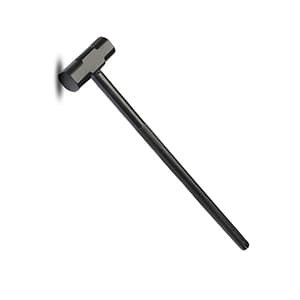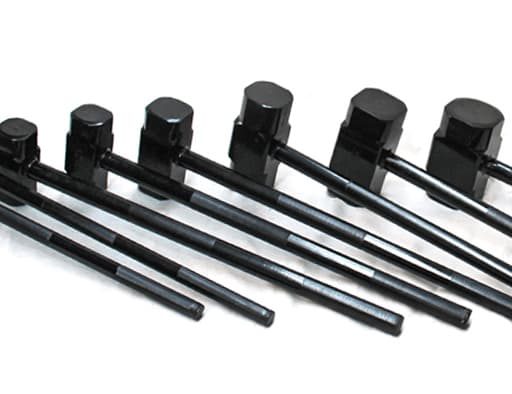What do Kettlebell Swings Work?
Kettlebell Swings (Muscles Worked, Benefits, Instruction Video)
Kettlebell swings are a very effective exercise that works all of the major muscle groups in the body. If you want to build muscle, lose fat, and increase strength, kettlebell swings are a great exercise. In this post, we respond to the questions, what do kettlebell swings work, and what muscles do kettlebell swings work (target), along with some ideas on how to do kettlebell swings correctly.
What Muscles Do Kettlebell Swings Work
Have you ever wondered which muscles kettlebell swings work? In a nutshell, kettlebell swings work your entire posterior chain. These large groups of muscles stretch from your neck to your heels at the back of your body and include muscle groups in both your upper and lower body, including:
Two Handed Kettlebell Swings Work
The traditional kettlebell swing is primarily a posterior chain exercise, so it will definitely work the following muscles:
- Calf muscles (soleus and gastrocnemius).
- Rhomboids.
- Quadriceps (rectus femoris and vastus medialis).
- Abdominal muscles.
- Grip (lower arm muscles and hand muscles).
- Gluteus maximus (gluteus).
- Erector spinae.
- Upper pectoralis major.
- Trapezius (lower and middle trapezius).
- Levator scapulae.
- Latissimus dorsi.
- Posterior deltoid.
- Hamstrings (biceps femoris, semitendinosus, and semimembranosus).
- Serratus anterior.
- Deltoids (anterior and lateral deltoid).
As you can see, the kettlebell swing works a lot of muscles! But it’s important to remember that the kettlebell swing primarily works the hips, not the arms, so the glutes and hamstrings (primary hip extensors) and lower back are working together.
One Handed Kettlebell Swings Work
The one-handed kettlebell swing is somewhat demanding on your body’s stability. Your abs, obliques, and serratus anterior muscles will get more work, as will your gluteus medius and minimus. All in all, the unilateral swing is great because it makes your stabilizers work harder to maintain a stable front upright position. Your shoulders will also definitely do more work to lift the kettlebell. That being said, it is still an exercise that focuses on the erector spinae, glutes, and hamstrings.
17 Kettlebell Swing Benefits
What are the benefits of kettlebell swings? Why should you add this exercise to your routine? Well, the benefits are incredibly numerous.
Everyone should include kettlebells in their workout routine because:
1. Build Muscles
Like barbell and dumbbell exercises, kettlebell swings are an anaerobic exercise that expends a lot of force in a short period of time. A small 2013 study also found that a 10-week kettlebell training program helped improve strength and power in weightlifting and powerlifting.
You’d be hard-pressed to find another exercise that works so many parts of your body. Kettlebell swings strengthen your core, glutes, hamstrings, quadriceps, back, arms, and deltoids.
2. Gives a Full-Body Workout
Kettlebell swings work nearly every part of your body. In just one exercise, you work your entire body language! That means it’s a very efficient use of your time. So, which muscles are you actually working? A single kettlebell swing works your entire posterior chain. This chain of large muscles stretches from your neck to your heels at the back of your body and includes muscles in both the upper and lower body, such as:
- Deloids.
- Grips.
- Chest.
- Glutes.
- Hamstrings.
3. Improves Cardiopulmonary Fitness
Research shows that kettlebell swings can help increase your aerobic fitness levels by increasing your heart rate and breathing, giving you a very effective aerobic workout.
4. Helps Burn Calories and Lose Weight
Do you know how many calories kettlebell swings burn? A study by the American Council on Exercise (ACE) found that the average person can burn 400 calories in just 20 minutes using a kettlebell. That’s an astounding 20 calories per minute, which is equivalent to running a six-minute mile! And that doesn’t even include the after effects of the burn!
Scientists attribute the rapid calorie burn to the fact that kettlebell exercise is a full-body exercise and can be done very quickly due to the interval training layout.
It’s a quick workout, and you really do get a lot of value in a short amount of time. The only other thing I could find that burns that many calories is a fast uphill cross-country winter workout.
If you’re on a weight loss journey, kettlebell swings can help you burn fat and build muscle at the same time. Members of the American Council on Exercise (ACE) believe that kettlebell exercise can help you burn twice as many calories as other strength training exercises.
According to a 2010 study by ACE, kettlebell exercises can burn up to 20.2 calories per minute, which is about what most people burn when working out at a 6-minute/mile pace.
5. Strengthens weak muscles
Sitting at a desk all the time can strain your hip flexors and hurt your back. And, if you already lift weights, many exercises only target the front of your body, which can lead to muscle imbalances.
Kettlebell swings can help loosen up your hips and strengthen any weaker posterior muscles, like your glutes, hamstrings, and lower back.
6. Loosens up your back
While more research needs to be done before we can say kettlebell swings can relieve back pain, this exercise may be a low-impact way to build back strength and mobility.
According to a small 2012 study, kettlebell swings may put the opposite stress on the spine than traditional weightlifting. This *might* be why some people believe kettlebell swings can help improve back function and health.
A 2017 study on hip and lower back pressure pain restrictions found that people who did kettlebell swings had reduced muscle sensitivity in that area.
This doesn’t suggest that this exercise can reduce back pain, but the researchers note that it’s worth studying how kettlebell swings might help relieve lower back pain or muscle soreness after a workout.
7. Build Practical Strength
Kettlebell swings work parts of your body you use every day. Holding the handle of the kettlebell during the swing or any other kettlebell exercise can help improve your grip strength.
In addition, the rotational motion creates a practical movement pattern that mirrors bending and lifting. Since the posterior muscles are being worked, you’ll be strong and perfect for everyday lifting and bending.
8. Improve Your Posture
To do a kettlebell swing correctly, you need to maintain good posture at all times – a posture you can carry over into other exercises and everyday life.
When you perform a kettlebell swing correctly, you keep your spine straight, your core and hips engaged, and your pelvis neutral. Rather than straining your back, this simple adjustment helps your body train to use your core and hip joints (that’s practical strength!) for great posture.
9. Practical AF
Kettlebell swings don’t require a gym membership or bulky equipment. All you need is some kettlebells in your living room or home gym.
You can easily do kettlebell swings while watching TV for a quick cardio and strength workout. No treadmill or big home gym setup required.
10. Improved Flexibility.
We’re not saying to miss out on your stretching routine, but kettlebells can help you gain flexibility due to the posterior chain being worked.
The rotational motion and hip thrusts used in the kettlebell swing open up the hips, extend the spine, and strengthen the back muscles to create greater flexibility.
11. Improved Flexibility
Every time you swing the kettlebell and straighten your torso, you engage your hip muscles, which loosens up the opposing hip flexors. Repeated tightening of the hips and loosening of the hips eventually unlocks tight hips… a common problem. This is partly due to today’s modern conveniences… we sit too high up! This can lead to a lack of hip flexibility.
The kettlebell swing is a great exercise to combat our modern sedentary issues. Improving hip flexibility can help make other exercises and sports activities more efficient, and take some pressure off your back.
12. Improved Balance
Studies have shown that kettlebell swings can improve balance and posture, even in top athletes. You’ll naturally learn what good posture feels like when using kettlebells. To maintain balance, you need to keep your back straight and your core tight.
Good balance isn’t just for ballet dancers, it’s for anyone who wants to avoid tripping over their own feet.
In a small 2013 study, people who exercised with kettlebells twice a week for 8 weeks saw improvements in dynamic leg balance.
A small 2020 study also found that ballet dancers who completed kettlebell training (including costumes and swings) improved their diving performance and balance more than professional dancers who took traditional diving and balance dance classes.
13. Improves strength and athleticism
Explosive movements mimic the muscle movements you use to run, jump, and lift weights. Since kettlebell swings effectively strengthen the “power zones” of the body, they are one of the most effective exercises for increasing athleticism.
The explosive movements of kettlebell swings mimic much of the motion required to run, lift, or jump effectively. According to a 2012 study, kettlebell swings can increase explosive power.
Essentially, it’s an overall force transfer. If you’re looking to improve your athleticism, kettlebell swings can help.
14. Improves heart health
You probably already know that aerobic exercise can benefit heart health because it uses oxygen and increases your heart rate. Since kettlebell swings count as aerobic exercise, they can keep your heart healthy, too.
A small 2021 study found that kettlebell exercises may also help lower blood pressure, but more research is needed in this area.
15. Low-impact
Traditional barbell training or high-intensity interval training (HIIT) workouts can put a lot of stress on your joints, but kettlebell swings don’t put as much stress on you.
If you’re dealing with an injury or weak joints, kettlebell swings can provide a low-impact strength-training option.
16. They’re friendly and practical
Compared to other strength-training exercises, kettlebell exercises like swings may be safer and work for people of all ages and skill levels. (And if you’re new to resistance training, they’re much safer than weightlifting.)
In a 2021 study of 35 adults (men and women between the ages of 59 and 79), researchers found that 17-pound kettlebell swings had similar effects to 52-pound deadlifts. As a result, the authors suggested that kettlebell swings may be a “simpler, easier, and more appealing” option. The study sample size was small, and virtually anyone can benefit from using a kettlebell.
17. It’s a game-changer
Kettlebell swings are powerful, which is why it’s a common exercise. It builds strength, flexibility, aerobics, and balance all at once… all at once. Build quality muscle and lose body fat fast. Once you own a kettlebell, it will be the game changer you are looking for!
Kettlebell Swings Weight
For beginners, we usually recommend 10 to 20 pounds for women and 25 to 35 pounds for men.
Anything under 10 pounds is probably not worth it. Start with something that gives you a little challenge but isn’t too heavy so you can learn how to use it properly. Then as you get stronger, you can slowly increase the weight. Eventually, you may even be able to lift up to 100 pounds!
How to Do Kettlebell Swings
When you do a kettlebell swing correctly, you need to keep your back straight, your core and hips tight, and your pelvis neutral. The kettlebell swing is a complex movement, here are some important tips:.
- Look straight ahead. Avoid looking down.
- Keep your feet in a comfortable position, slightly wider than shoulder width.
- Keep your back straight and avoid hunching over.
- Lower the kettlebell between your legs and push your hips forward. It is important to use your legs and hips to quickly raise the kettlebell. Remember, it’s all in the hips!
- The kettlebell should be raised to chest level with your arms parallel to the ground.
Full Body Kettlebell Workouts
The kettlebell swing is arguably the most important kettlebell exercise. In its simplest form, the kettlebell swing involves holding the handle of a kettlebell and swinging it from between the knees to head height with one or both hands.
The kettlebell swing works nearly every part of the body. Researchers have found that kettlebell swing exercises can reverse stress on the posterior discs in the lower back (i.e., L4 and L5). The kettlebell swing works so well that it’s why it’s become a staple exercise.
In short, you’ll get amazing results if you add kettlebell swings to your workout.




